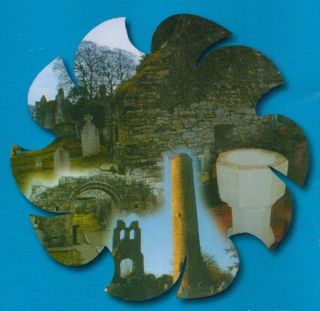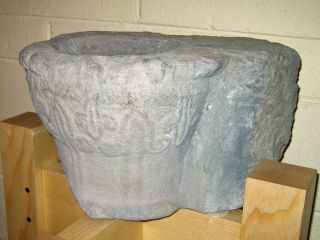Early Christian Navan
Early Christian Navan

(left) Collage showing the ancient
parishes of Athlumney,
Cannistown, Donaghmore,
Ardsallagh and
Dunmoe which were
joined with Navan to make
up the modern St. Mary's
Catholic Parish.
In the area which forms the present parish of Navan - [it is a union of the medieval parishes of Navan, Ardsallagh, Cannistown (Balreask), Donaghmore, Dunmoe and Athlumney] - there were at least two churches which had their origin in the first years of Christianity in Ireland, one at Donaghmore and the other at Ardsallagh.
Of the first Church and Monastery at Donaghmore, Tirechan, a monk of Ardbraccan, who lived about the year 700 and wrote a life of St. Patrick, mentions that Patrick gave the church at Donaghmore to a priest, Cassan, stating that his establishment on earth would not be a great one; strangely enough the Church got its name from its size, the Great Church, and a minor monastery survived there until the coming of the Normans. That it was minor we know, because in spite of the round tower which still survives, the monastery is mentioned only twice in the annals of the Four Masters; once in 845 when it was reported that Robhartach Mac Flainn died abbot of Donaghmore and again in 854 when it was plundered by the Vikings.
In one of the deeds preserved in the Book of Kells, it is stated that the monks of Kells bought, for twenty ounces of gold, the lands of one O'Riaman in Donaghmore. The deed is witnessed by O'Dunan, Bishop of the northern half of Ireland, the King of Tara and O' Fiachiach, erenagh or custodian of Donaghmore. It is dated just before 1094 when we know Bishop O' Dunan died.
The monastery, of course, like all the early Christian monasteries was not exactly like a monastery of today. It was a collection of wooden huts surrounded by one, two or three lines of circular ditches with, perhaps, a stone church and round tower and stone crosses, (like those of Kells), at the entrances. It was inhabited at first by a celibate clergy, but gradually there grew up at the monastery, a community of married clergy and laymen, called Mainig, who formed together a Christian Community which owed more to the style of life of the Celtic people than it did to the eastern monasteries on whose rule was modelled the first rules of Irish monastic life.
The early Christian monastery of Ardsallagh has its foundations attributed to St. Finian (died 552) founder of Clonard, patron of the Diocese of Meath and the man largely responsible for the monastic character the Irish Church adopted after the death of Patrick. The monastery, dedicated to St. Brigid, must have been small as it too, is not been mentioned in the Annals. It is a fair assumption as it did not endure the honour of a Viking raid worthy of note in the Annals. It had neither wealth nor size nor contemporary importance to recommend it. No trace of this monastery remains.
Navan Abbey

(left) The pre Norman font from Navan Abbey.
The font, with its Romanesque designs would
date it to the pre Norman period, and older than the town itself.
Photo © N&DHS
Today it can be found in the Oratory of St. Patrick's Classical School Navan.
[It was incorporated into the chapel of the De la Salle Brothers - in an upper room in what was once the Colonel's house - when a military barracks was built on the site of the Abbey around 1700]
The third pre Norman religious house in Navan parish was the Abbey of Navan itself. There are only shadowy references to Christian presence in Navan in the early years.
A story has been preserved that St. Fechin, legendary foundary of the great monastery at Fore, got a cool reception from one Faelanus at Navan when he proposed founding a monastery there.
Again at a place called Nua Chongbhail or Navan, the Annals tell us a St. Fachtna whose feast is on January 19th, founded a monastery but again like the establishment of Ardsallagh, there is no further reference in the Annals. We do know, however, that before the Normans came to Ireland there was a Monastery at Navan. By the twelfth century, many of the Celtic monasteries had fallen into decay and were often Christian communities whose life style was little different from that of their non monastic neighbours.
St. Malachy of Armagh introduced into any Celtic monastery where organised religious life had survived, a rule which from 1050 on, had been transforming monastic life in Europe. It was based on the rule which St. Augustine had drawn up to regulate the life of the priests who, with him, formed the Catholic clergy of his bishopric of Hippo. A more special and severe form of this rule, discovered by St. Malachy in a monastery at Arrouaise in Artois in north west France, and based partly on the Cistercian rule approved of by St. Bernard of Clairvaux, was introduced into many monasteries in Ireland including the Abbey of Navan.
Whether it was a new monastery or the remains of an old monastery at Navan or a new dwelling for the monastery at Ardbraccan, (which was to disappear from the records after 1170), we do not know. But we do know that O'Rourke of Breffney (he was the man who drove Dermot MacMurragh to bring in the Normans), gave, in 1169, to Navan Abbey, lands some of which, at Grange and Faughan Hill, it was to hold for 400 years. The rest were lands from the confluence of the Boyne and Blackwater - from Leighsbrook at Navan - to the Gowra river which enters the Boyne at Dowdstown.
For the 700 years after St. Patrick brought Christianity to Ireland, there are only faint traces of specific churches at Navan, yet there is enough evidence to indicate that the Mass and Sacraments and Christian living were there to shape the lives of the Celtic people who lived in the area.
Fr. Gerard Rice